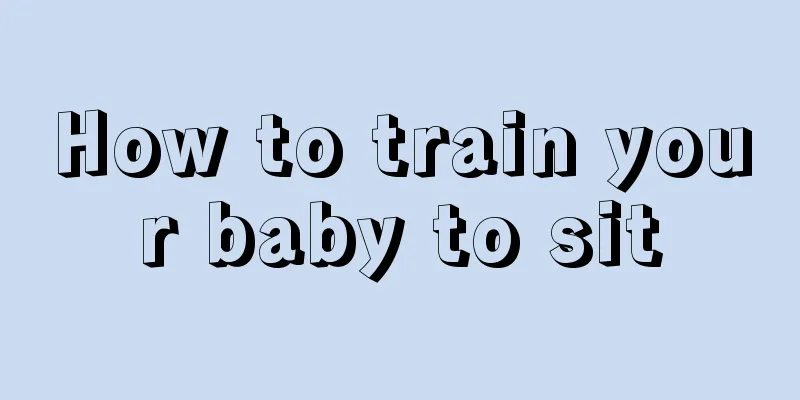How to train your baby to sit

|
As babies grow up, they will learn various abilities. For example, teaching babies to sit is something parents need to do. However, if you want your baby to learn to sit successfully, you don’t have to rush for success. This requires parents to master certain skills and have a certain amount of patience. When necessary, you can also use some work to help the baby successfully learn how to do it.
Training period: often used in the early and middle stages of sitting training. Function: Strengthen the child's lateral balance and hand support and protection ability. Key points of the action: The adult sits behind the baby, holds the baby with his arms around him, supports the baby's shoulder with one hand, and holds the baby's elbow with the other hand, allowing the baby to stand upright with one hand, thereby training the baby's hand support ability and lateral balance ability. Do this movement alternately on both sides, you can do the right hand first and then the left hand. 2. Long sitting training Training period: often used in the early and middle stages of sitting training. Function: It is intended to assist in supplementing the strength of the waist and back or to strengthen the baby's awareness of protection through the support of the front hands. Key points of the action: The adult sits behind the baby, presses the baby's lower limbs with both hands, and keeps the other lower limbs in an abducted position, so as to train the baby to sit upright. The baby can sit in a regular position or support himself with both hands in front of him for training. Note: If this training is performed on a triangular mat (hips high and legs low), it can effectively improve the baby's awareness of sitting upright and liberate the upper limbs to a certain extent.
Training period: suitable for babies who already have good sitting ability. Function: In addition to strengthening the baby's body position change training, it also helps to further enhance the sitting balance. Key points of the action: The adult sits beside the baby, holds the baby's shoulders and elbows with his arms, and makes sure the baby supports his body with his elbows first, and then with his hands. Let the baby slowly stand up from a supine position to a sitting position, alternating between the two sides for training. 4. Sitting body axis rotation trainingTraining period: suitable for babies who already have good sitting ability. Function: Aims to strengthen the trunk rotation ability, promote the static and dynamic stability of the child's trunk in a sitting position, and lay the foundation for body position change and more advanced motor skills. Key points of the movement: Let the baby sit on the adult's thighs, and through the up and down movements of the adult's legs, support the baby to complete the body axis rotation training, so that the baby's hand can touch the opposite foot. 5. Peanut ball/roller sitting training Training period: suitable for babies who already have good sitting ability. Function: Aims to strengthen the front and back strength of the waist and abdomen of children, sense of balance, and improve their ability to sit upright. Key points of the action: Let the baby sit on the peanut ball, and the adult sits behind the baby, puts his hands around the baby's front and holds the baby's thighs, and slowly moves the peanut ball back and forth to stimulate the abdominal and waist muscles. 6. Sitting training on the Babbitt ball Training period: suitable for babies who already have good sitting ability. Function: Aims to strengthen strength and balance in all directions while sitting. Key points of the action: Let the baby sit on the peanut ball, and the adult sits behind the baby, puts his hands around the baby's front to support the baby's hips, and slowly performs up and down vertical training to stimulate the baby's spine. You can also do front-to-back rocking exercises to train your baby's front and back balance. And conduct left-right shaking training to train the baby's lateral balance ability. |
<<: What to do if your baby gets herpes on his hands
>>: What to do if blisters appear on children's hands
Recommend
Why does my baby always scratch his ears?
When a baby is feeling uncomfortable, there will ...
What should I do if my baby has a fever after falling?
It is very easy for babies to fall down. Some bab...
Symptoms of zinc deficiency in 3-month-old babies
As parents, we should pay attention to the three-...
What can children eat to get better quickly when they have a fever?
Children cannot eat seafood, eggs, or soy product...
My daughter's breasts started to develop at the age of nine.
Breasts are very important organs for women. Not ...
Can babies eat noodles if they have diarrhea? I understand everything after reading it.
If the baby has diarrhea, parents can feed the ba...
Is gastroscopy harmful to children?
Gastroscopy can be applied not only to adult pati...
Causes of chest tightness and breathing difficulties in children
With the development of society, the improvement ...
Tips for constipation for seven-month-old babies
Seven months is a critical period for the develop...
How to deal with baby's burns and broken skin
Babies are lively and active, and they are very c...
How to judge the baby's intestinal malformation
Parents are usually very nervous about their newb...
My child always wants to urinate after urinating
Some children do not pay attention to their priva...
Is it normal for newborns to have skin shedding?
The functions of newborns are not fully developed...
What should I do if my child’s hair doesn’t grow long?
Mothers with children at home are often troubled ...
Why does a child have a runny nose after having a fever?
Children and the elderly who are physically weak ...









